
For many, phones are starting to replace televisions as the primary device for watching videos. Thanks to their portability and easy to use apps, it's often simpler to watch Netflix, Hulu, YouTube, or Prime Instant Video on the smaller screen. But not every phone is suited to fit this need, so we did some testing to find the best of the best when it comes to streaming videos.
We looked at all current-generation phones and evaluated their specs and the features that lend themselves to an enjoyable watching experience. Our primary focus was on the screen, the audio, and all the little details that come into play when your stream a video, and we used that set of criteria to narrow down the field to the five best phones to accomplish that task. While we are aware that better overall phones exist, the phones on our list are best for those who use their phone primarily as a mini-television.
This ranking looks at all phones, regardless of cost. If you're working with a budget, we've done a separate comparison of the best sub-$500 phones for streaming videos, and you can check that out at the link below.
Table of Contents
Comparison Chart
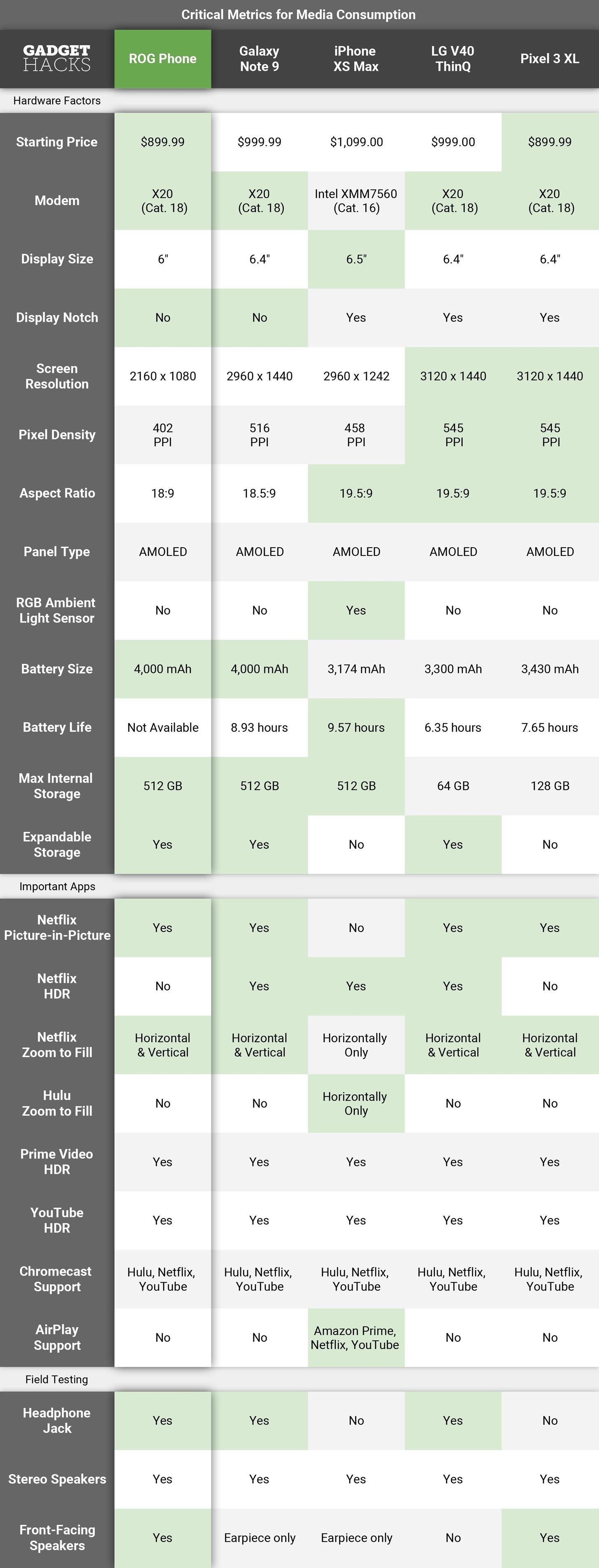
Key Comparison Points
- Starting Price: The current price of the base model of this phone.
- Modem: The modem used by the SoC found in the phone. This hardware component is directly responsible for managing your LTE cellular data connection. Modems are measured in categories, with higher numbers indicating faster theoretical max speeds. With today's higher resolution videos and HDR, a consistently high data speed is needed to prevent buffering, or worse, downgraded resolution.
- Display Size: The size of the screen. Easily one of the most important criteria on our list, a larger display provides the best video watching experience. Every phone on our list is at least 5.5".
- Display Notch: The controversial notch included in some phones to help reduce the size of bezels. However, the notch disrupts the symmetry of the screen, forcing videos to either stop short of the bezel or push the video around it, removing a section of the screen.
- Screen Resolution: The resolution of the display. Every phone on our list is at least 1080p.
- Pixel Density: The best measure of a display's sharpness. If you multiply the resolution numbers (see above), you'll find the total number of pixels in a screen. Then, if you divide that number by the total area of the screen, you'll see how many pixels are in a square inch of the display. The higher the PPI number (pixels per inch), the sharper the screen.
- Aspect Ratio: The ratio of the width of a display compared to its height. This number comes into play when watching movies, as the aspect ratio of films is displayed differently depending on the aspect ratio of your screen. When compared to 16:9 screens, 18:9 (or taller) screens won't show horizontal black bars for 1.85:1 videos (which is typical of older movies such as The Godfather), and black bars will be smaller with 2.39:1 videos (found on newer movies such as Netflix's The Cloverfield Paradox).
- Panel Type: The type of display panel used by the device. For smartphones, there are currently two options: LCD and AMOLED. Although there are variations of these two, the underlying technology is always the same. AMOLED is Samsung's marketing term for OLED, and it offers the best contrast ratios with its ability to display black without light bleed.
- RGB Ambient Light Sensor: An upgraded ambient light sensor which detects the color temperature of the surrounding area to adjust the white balance on the smartphone's display. Apple popularized the usage of this sensor with their True Tone feature. While there are Android phones which try to emulate this feature, the only phone on our list with the sensor is the iPhone XS Max.
- Battery Size: The capacity of the battery included in the smartphone. While it doesn't paint the whole picture (specifically with Apple's iPhone X), higher capacity does greatly assist in better battery life.
- Battery Life: Using GSMArena data, we collected the battery life of each phone while playing a video from 100% to 10%. Brightness was held at 50%, and the video was a standard definition video which looped while airplane mode was enabled.
- Max Internal Storage: The largest size of the internal storage available, measured in gigabytes. With most streaming services offering the ability to download movies and TV shows onto the device for offline viewing, having a phone with larger storage is helpful. Most apps allow you to choose the quality of the downloaded video, with higher resolution creating a larger file size.
- Expandable Storage: Whether the smartphone supports storage expansion. While Huawei did release the Nano SD card, most phones only support expandable storage via microSD cards. Expandable storage allows users to overcome the limitation of their internal storage to download even more files to view on the go. Every phone on our list which supports the feature includes support for microSDXC, which has a maximum theoretical capacity of 2 TB. This card doesn't exist at the time of writing, but you can get a 512 GB microSD card.
- Netflix Picture-in-Picture: The ability to view Netflix content in a small floating window. Thereby, you can perform another task in full screen while still enjoying Netflix movies. This feature requires Android 8.1 Oreo or higher.
- Netflix HDR: The phone supports viewing Netflix content in HDR. Even if the phone's display supports HDR, Netflix has to add support on their end. As a result, only 14 smartphones support HDR (via either HDR10 or Dolby Vision).
- Netflix Zoom to Fill: The ability to zoom Netflix videos, in order remove horizontal and vertical black bars. While this may crop the video, it does allow you to use more of the screen for a more immersive experience. The zoom to fill ability varies based on the operating system and the display's aspect ratio.
- Hulu Zoom to Fill: The ability to zoom Hulu videos, removing horizontal and vertical black bars.
- Prime Video HDR: The phone supports Amazon Prime Video in HDR. According to Amazon, only five phones are supported.
- YouTube HDR: The phone supports HDR content on YouTube.
- Chromecast Support: Which of the popular streaming apps the device can be displayed on an external device such as a television via Chromecast or Google Cast. Chromecast is supported on both mobile operating systems and therefore supported by all phones on our list.
- AirPlay Support: Which of the popular streaming apps the device can mirror to an Apple TV device to continue playback on a television. AirPlay is typically exclusive to Apple devices and therefore only supported by the iPhone XS Max.
- Headphone Jack: Whether or not the phone includes a 3.5 mm headphone jack. With smartphones' portability element, headphones might be necessary to enjoy in a more noisy environment. And while there is always the option of Bluetooth, wired headphones offer better clarity, sound, and have far more options.
- Stereo Speakers: Whether the phone includes stereo speakers. With stereo speakers, the phone must include at least two different speakers allowing for more rich and clear audio. The improved quality helps with hearing dialogue and scores of movies as you watch.
- Front-Facing Speakers: Whether the phone orients both speakers toward you. A handful of phones on our list use a bottom-firing speaker in combination with the earpiece, which is effective but isn't better than two speakers directed toward your ears. With front-facing speakers, movies are easier to enjoy as audio can be heard easily.
How We Picked These Phones
We focused strictly on phones released on or after January 1, 2018. At the time of this writing, all major phone releases have occurred for the year. This provides many options which all utilize the latest hardware, including SoC, modem, and display. Therefore, it makes little sense to look at older phones, as they would be using obsolete hardware.
We also only looked at phones officially released in the US from a carrier or major retailers. Therefore, you won't find any Xiaomi, Meizu, and many of the better offerings from Huawei. While you can import these devices into the US, often they will not have the proper radio bands to work on US wireless carriers. They will also not come with a manufacturer warranty (and oftentimes, no warranty at all), making them not ideal for US customers.
Once phones cleared these two hurdles, we started to thin the herd based on their specifications, beginning with the display size. No phone on our list has a display smaller than 5.5 inches. With so many phones nowadays having displays over 6 inches thanks to shrinking bezels, there is no reason to settle for a smaller screen. A larger display gives you more real estate to view and makes subtitles easier to read. We chose 5.5 inches as the absolute minimum, but every phone that made our list is at least 6 inches.
Finally, instead of having multiple phones from the same OEM, we instead focused on the best offering. For example, while the Samsung Galaxy S9 and S9+ are great considerations for our list, because the Samsung Galaxy Note 9 is even better when it comes to media consumption, we only listed it. And in the case of multiple-size phone lineups such as the iPhone XS/Max and Pixel 3/XL, we choose the larger of the two, as a bigger screen is always desired when it comes to media consumption.
Phone 1: ROG Phone
When Razer kicked off the gaming phone trend with 2017's Razer Phone, I was excited. Not because I'm a big mobile gamer — instead, I was excited about how, in making a fantastic gaming-centric phone, Razer had also created an excellent phone for media consumption. Fast forward to this year, and ASUS has joined Razer in the gaming phone industry with a strong challenger for the title of best gaming phone. In fact, they managed to not only supplant the Razer Phone on this very list, but top its previous ranking.
The ASUS ROG Phone has just about everything a mobile gamer would need to get the best experience possible, and these features carry over to an improved experience while watching videos. From its display to its accessories, ASUS has managed to create a complete package for those who want to game or consume media.

The ROG Phone uses a 6-inch AMOLED panel. This display has a 108.6% DCI-P3 color gamut for accurate color reproduction. It's fully capable of streaming HDR content via YouTube and Amazon Prime, but isn't certified for Netflix yet. Unlike most of the phones on our list, it doesn't use a display notch, so the screen isn't obstructed by the controversial addition. It uses an 18:9 aspect ratio, making it ideal for both YouTube videos and movies from all eras, as zooming in doesn't crop too much of the video or leave thick letterboxing. While it is "only" a 1080p display, the lower resolution does help with battery life, especially when paired with its ridiculously large 4,000 mAh battery.

However, when it comes to media consumption, the audio is just as important as it draws you in and enhances the emotional connection with the content on the screen. ASUS didn't skimp in this department at all, providing a great audio experience whether you are using the phone speakers or a pair of headphones.
ASUS included a pair of stereo speakers, and it's one of only two phones on our list which position the speakers toward you. Additionally, both speakers are powered by their own NXP 9874 smart amplifier, allowing for audio to get incredibly loud without compromising the quality of the sound. And for those who prefer headphones, ASUS includes a rare 3.5 mm headphone jack. Additionally, thanks to Android 8.1 Oreo on board, the ROG Gaming Phone supports Hi-Fi wireless audio including aptX HD and Sony's LDAC. And for an even better experience, the ROG Gaming Phone supports the new DTS:X Ultra 1.0 which provides 7.1 surround sound for your content, whether using the phone's speakers or a pair of headphones.
Because it is a gaming phone, ASUS includes a gaming mode which not only boosts performance for games but minimizes notification interference. You can use this same mode when watching videos so that you are not interrupted by a text message. ASUS also created several accessories to improve the gaming experience including the WiGig Dock, which mirrors your screen to the television. However, unlike Chromecast, it leverages the new 802.11ad Wi-Fi protocol capable of Wi-Fi speeds up to 7 Gbps. Therefore, your connection is smooth and high quality, and requiring no reduction in resolution.

These are just some of the features included in the ROG Phone. There are many more additions that are geared towards gamers, including a lower response time screen, higher refresh rate, an overclocked CPU, and much more.
In the quest to create the best gaming phone, ASUS built a media consumption powerhouse. It might not have the biggest screen or highest resolution, but it lacks almost no feature that media consumers would want and even has accessories that enhance the experience.
Phone 2: Galaxy Note 9
Despite the fact that Samsung recycled its design from last year, the Galaxy Note 9 is a major upgrade from its predecessor. It isn't much of stretch to say that besides the design, everything has been upgraded from last year's Galaxy Note 8, which was already a great phone, especially for watching movies. This year, it got an improved display, a bigger battery, and better speakers, allowing it to easily get the number two rank on our list.
With the Galaxy Note 9, it all starts with the display. It has a 6.4-inch 2960 x 1440 screen which uses Samsung's Super AMOLED technology. It is well known that Samsung reserves the very best displays for its own products and the Galaxy Note 9 is no exception. According to DisplayMate, the Note 9 received a record "Very High Absolute Color Accuracy" that is "visually indistinguishable from perfect". DisplayMate also notes that Samsung managed to increase the brightness by 27% from last year's Galaxy Note 8 and improve contrast by 32%. The Note 9 matched or set many of the Display Performance Records as measured by DisplayMate, earning the website's highest grade of A+.


With such a beautiful and large display, Samsung knew they need a battery large enough to power this for the day (and even longer, depending on your usage). To accomplish this, they paired it with a massive 4,000 mAh battery. This is the highest battery capacity for the Galaxy Note series and tied for the largest battery on our list. However, battery capacity isn't the whole story, as other factors come into play when deciding battery life, including how the operating system manages resources. Fortunately for the Galaxy Note 9, the extra large battery was worth it, achieving over 16 hours of usage when watching a video, 5 hours more than second place.
As with its predecessor, the Note 9 supports HDR on the major video streaming services, including Netflix, Prime Video, and YouTube. While Netflix and Prime Video are limited to 1080p streaming, YouTube can take full advantage of Note 9's 1440p resolution, allowing videos to display up to 60 fps with HDR at this resolution.

Thanks to the Galaxy Note 9's 18:5.9 aspect ratio, most videos utilize the entire screen. For YouTube, you will deal with black bars for many videos unless the content creators shoot it in a 2:1 aspect ratio. However, for most movies, you will hardly see black bars. For some older movies, the Galaxy Note 9 will display the video zoomed a bit horizontally and vertically, with a bit of cropping. However, you can always zoom out to see the movie in its original aspect ratio.
Samsung also brought over the AKG-tuned stereo speakers they introduced with Galaxy S9, providing speakers that are clear and loud. However, unlike others on our list, only the earpiece faces toward you, using a bottom-firing speaker as the second speaker. But it is one of only three phones on our list which includes the headphone jack.
The Galaxy Note 9's new stylus can also help with video playback. The new Bluetooth S Pen can pause and play video, so you can control your video even from a distance. Samsung is opening the SDK to third-party developers, so apps such as Netflix and Prime Video can create specific features for customers using the stylus within the app.

If you want the best display with one of the highest resolutions available to phones, the Galaxy Note 9 is your choice. Samsung continues to improve their AMOLED panels to create an accurate display which looks stunning. Paired with an all-day battery life to match, support for HDR, and the second-largest display on our list, this is about as good as it gets for streaming. With the Note 9, you can sit back, relax, and enjoy a mini home theater in the palm of your hand.
Phone 3: iPhone XS Max
For the past few years, iPhone fans looked enviously at Samsung and other Android phones as they pushed toward a bezel-less phone. While Android phones have been reshaping the phablet category for years, Apple has stood pat with their phones never eclipsing the 6-inch screen size mark. This all changed with the iPhone XS Max.
The iPhone XS Max is the iPhone with little compromise. It follows the 2018 trend of a large display in a small footprint, resulting in a display 0.7 inches larger than last year's iPhone X. It has the highest resolution display and the largest battery ever in an iPhone. All of this combines to be a fantastic phone to watch your favorites shows.
The iPhone XS Max has one of the best screens on any phone. According to DisplayMate, it is one of only four top tier smartphone displays which provide close to "Text Book Perfect Calibration Accuracy and Performance that is Visually Indistinguishable From Perfect," which resulted in it receiving DisplayMate's Best Smartphone Display Award. Its 6.5-inch display has minimal screen reflection, a peak brightness level of 660 nits, a high contrast ratio, and high color accuracy. This display quality is only matched by the Galaxy Note 9, Galaxy S9+, and Pixel 3 XL.

Unfortunately, the display notch returns. With this notch, the symmetry is lost, as one portion of the screen is cut off thanks to the extended bezel that houses Face ID. When watching videos, users have to decide whether to lose some screen real estate and keep the symmetry by using vertical black bars or use the entire screen and have a portion of the video blocked by the notch. This controversial addition will be a dealbreaker for some.
Another questionable decision is the lower resolution when compared to Android phones with similarly-sized screens. Instead of opting for a 1440p display, Apple decided that keeping a similar pixel density to its other models was more important. The iPhone XS Max has the same PPI has its little brother, the iPhone XS, resulting in an unconventional resolution of 2960 x 1242.
Similar to the ROG Phone, the lower resolution will assist with battery life, as the GPU is driving fewer pixels. However, the screen is significantly larger than the one on the ROG Phone, and larger displays benefit from higher resolution, as overall sharpness is a product of screen area divided by resolution. So while Apple may have achieved the highest battery life on our list, video won't look quite as good when compared to 1440p devices.

Besides its amazing screen, another big advantage of the iPhone XS Max is the iOS platform. iOS is the only mobile operating system which officially supports both Chromecast and AirPlay, giving users options when it comes to sending videos to the big screen. With both a Chromecast (or Google Cast-compatible device) and Apple TV, all the popular streaming apps can be mirrored to your television for an even better experience.
There is no iPhone better for media consumption than the iPhone XS Max. With the highest battery life on our list, internal storage options up to 512 GB, and even louder stereo speakers, this is best Apple device to get if you mainly use your phone to watch Netflix and Hulu. While there are some slightly better Android options, you won't go wrong with this device, especially with its industry leading display.
Phone 4: LG V40 ThinQ
While LG's mobile division has been struggling for years, the one series that that has been doing well for them is the V lineup. Partially because of this recent success, LG made some "questionable" releases to the series, such as the V30S ThinQ and V35 ThinQ. However, the true successor to 2017's LG V30 was the LG V40 ThinQ. This device expanded the video playback capability of its predecessor by improving both the heavily criticized display and the speakers.
In many ways, the LG V40 ThinQ and the Google Pixel 3 XL are similar. Both have a 6.4" AMOLED display. Both have 3120 x 1440 resolution, leading to the same pixel density. Both include notches for the first time in the series (although LG's is much less intrusive), leading to the use of a 19.5:9 aspect ratio. And both run the same SoC with the same Adreno 630 GPU at the helm.

Where the difference lies is in the audio and display. The LG V40 ThinQ uses a panel developed by LG for its AMOLED display. LG received a lot of criticism after their return to manufacturing OLED panels for last year's LG V30 and Google Pixel 2 XL. However, with a year under their belt, LG has improved the display, fixing the blue tint and "burn-in" problems which plagued last year's panel. While this panel isn't as good as the Samsung panel used in Galaxy Note 9, iPhone XS Max, and Google Pixel 3 XL, it is comparable and will offer the amazing image quality you've come to expect.
Where the LG V40 ThinQ really shines is in the audio department. LG has introduced new phone speakers, known as Boombox, which it first debuted with the G7 ThinQ. The Boombox speakers use a resonance chamber to amplify the sound. With this iteration, LG has added a second speaker to the mix to increase the volume and the quality of the sound further. Just like the G7 ThinQ, the sound is amplified even more when laid on a surface.

Then there is the headphone jack. Where most OEMs are abandoning the port (I'm looking at you OnePlus), LG has doubled down on it by not only including the port, but improving it using a 32-bit Quad DAC. Thanks to this digital-to-analog converter, the V40 ThinQ can properly power better headphones, providing you the best audio experience in any phone. And, for movie watchers, users can take advantage of DTS:X Virtual Surround, which replicates surround sound audio using the two speakers of a headphone (or the phone's speakers), providing an immersive experience.

One of the biggest limitations of the V40 ThinQ is its price and its storage options. Unlike every other phone on our list, there is only one storage option for the V40, 64 GB. This is the lowest internal storage of any phone on our list. Fortunately, it does support expandable storage via microSD card. The problem is even with its similarity to the Pixel 3 XL and low storage option, LG decided to charge the same price as the Galaxy Note 9, tied for second most expensive on our list. While price isn't terrible by itself, the idea that you can get a phone very similar to this device for $100 less is a disadvantage for LG.
Phone 5: Pixel 3 XL
While the Google Pixel 3 XL might not be the best overall Android phone, it is an excellent phone for Prime Video, Hulu, and other video services. Google is one of only a handful of companies that continues to support front-facing speakers, even if it resulted in a not-so-popular display notch. And with its much-improved display, the Pixel 3 XL is one one of the best options for video playback, although it does have a few shortcomings.
The Pixel 3 XL trades in last year's heavily criticize LG POLED display for a Samsung AMOLED. While LG's POLED is much improved from last year, Samsung's panels are still ahead, as Samsung has had years to perfect them. The result is the first Pixel device to receive DisplayMate's highest assessment grade of A+. The new screen is one of the most color accurate displays on a smartphone, with its overall performance rivaling Apple and Samsung's best offerings.

The Pixel 3 XL shares the title of the highest resolution despite "only" being 6.4 inches. With its 3120 x 1440 resolution, it is tied for the highest PPI on our list. It also has the second largest battery capacity on our list at 3,430 mAh, leading to an impressive 7+ hours of battery life when watching videos. It is also tied for the cheapest phone on our list at $899.99, making it one of the better values here.
One of the biggest standout features of the Pixel 3 XL is its front-facing stereo speakers. First introduced to the Pixel lineup in last year's Pixel 2 and 2 XL, this component has been improved with 20% louder speakers and even cleaner audio. Unfortunately, there is no headphone jack, so users are stuck using the included dongle for wired headphones. However, with Android 9.0 Pie at the helm, Pixel 3 XL owners can enjoy the latest Hi-Fi audio codecs, including Qualcomm's aptX HD.

One of the biggest shortcomings of the Pixel 3 XL is its lack of certification for Netflix HDR. Despite having such as gorgeous screen capable of HDR content, users will be stuck with viewing non-HDR Netflix video until they get certification. However, you can view HDR content on YouTube and Prime Video, and the Pixel 3 XL is a YouTube Signature Device, for what that's worth.
It is the only phone on our list running Android 9.0 Pie and will be first to get the next version of Android, Android Q. This means if Android Q adds new features to the benefit of media consumers, the Pixel 3 XL will be the first to get it, and the only device to have it for some time.
Despite its last position on our list, you can't go wrong with the Pixel 3 XL. Its front-facing speakers and industry-leading display make it a great choice for your mini-television. It also benefits from having fast software updates, allowing it to add new features weeks or months before the other phones on our list. And thanks to its underclocked CPU, it has better than average battery life, ranking third on our list.
Conclusion
You honestly can't go wrong with any of the phones on our list. Whether you are a fan of Android or iOS, both operating systems have great options for movie and TV lovers. 2018 has been an excellent year for phones in this category, as there are so many options for large displays that use AMOLED. And with more and more phones including stereo speakers, you can be sure that audio will be good as well.
The best offering currently available is the ASUS ROG Phone. In the process of making one of the best gaming smartphones, ASUS created the best phone for movie watchers. With its incredible display, large battery, and innovative accessories, you can't go wrong with he ASUS ROG Phone.
This article was produced during Gadget Hacks' annual Movies & TV on Mobile special coverage. Read all of the Movies & TV on Mobile coverage.
Just updated your iPhone? You'll find new emoji, enhanced security, podcast transcripts, Apple Cash virtual numbers, and other useful features. There are even new additions hidden within Safari. Find out what's new and changed on your iPhone with the iOS 17.4 update.
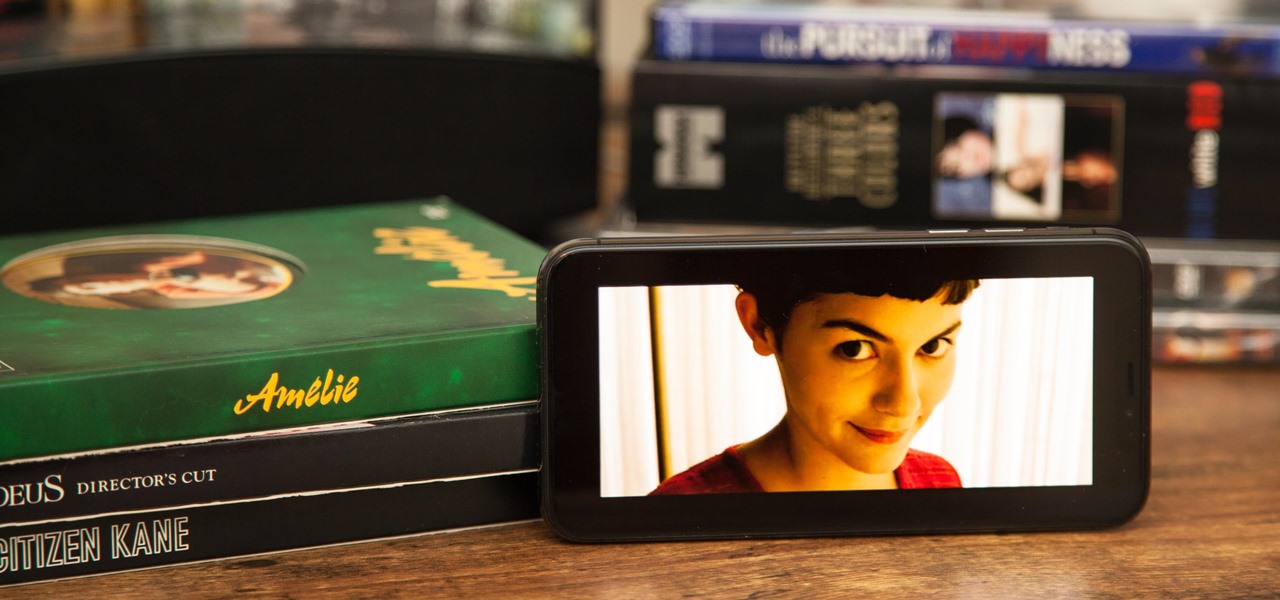




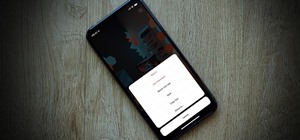



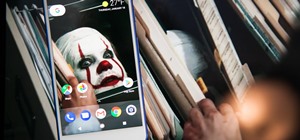
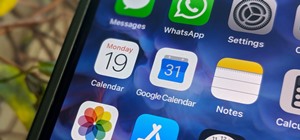
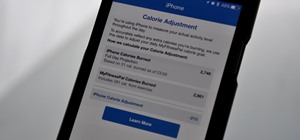
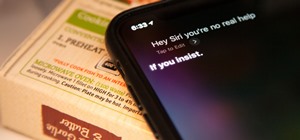
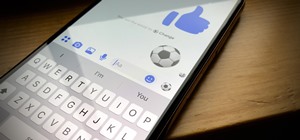

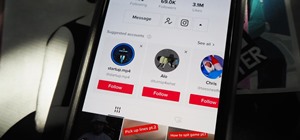
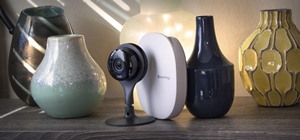
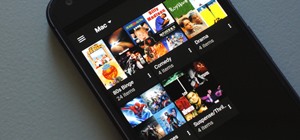
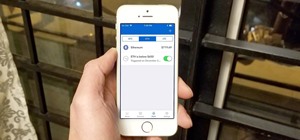
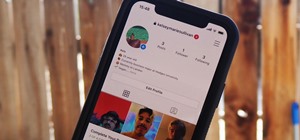

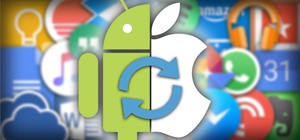
Be the First to Comment
Share Your Thoughts